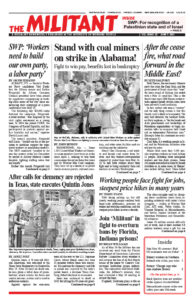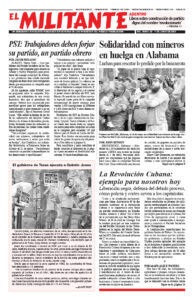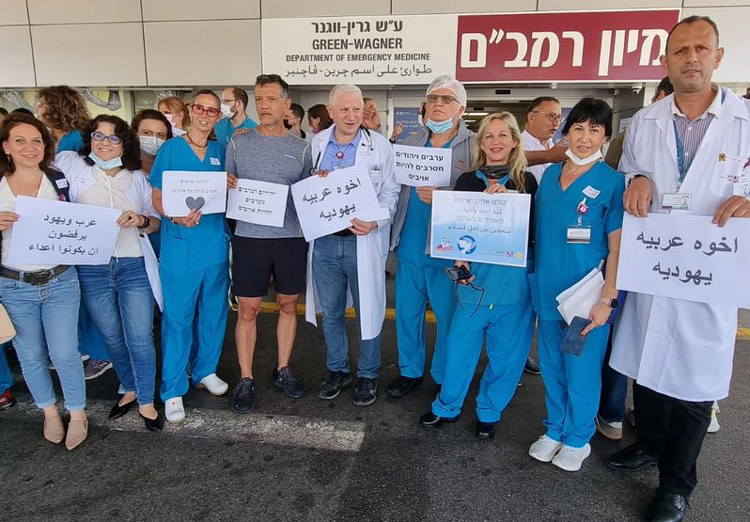Both Hamas, the reactionary Islamist party that rules the Gaza Strip, and the government of Israel claim they “won” the latest round of fighting that ended with a May 21 cease-fire. This is the fourth time since 2008 Hamas rocket attacks against Israeli civilian areas have been met with Israeli retaliation.
In fact, neither side won a “victory,” and the only thing certain is that this bloody cycle is likely to be repeated. The only road forward, the Socialist Workers Party explains, is “for the Israeli and Arab governments and leaderships of Palestinian organizations to begin immediate talks to recognize both Israel and an independent Palestinian state.” (Excerpts from this statement are available on page 8.)
Until then, it is working people in Israel and the Palestinian territories who will pay the price.
Hamas fired more than 4,300 missiles targeting civilians in Israel, killing 12 people, including three immigrant workers and two Arab citizens. Some 242 people were killed in Gaza by Israeli airstrikes or, in some cases, by Hamas’ own rockets falling short. Those killed were mostly Hamas and Islamic Jihad combatants, as well as children and other civilians.
Much of Gaza lies in rubble from Israeli strikes that hit 1,500 rocket launchers, command posts, ammunition stores and tunnels that Hamas deliberately placed in working-class neighborhoods.
This time there was a new development, as small groups of Arab youth waving Hamas and Palestinian flags attacked synagogues and Jewish businesses, homes and individuals. And small groups of Jewish Israeli right wingers attacked Arab businesses and homes, desecrated Muslim cemeteries and beat Arabs in “mixed” cities.
Most working people, Jewish and Arab alike, oppose these attacks. Palestinians helped douse the flames when the Dossa Synagogue in Lod was set on fire by rioters and denounced the violence against Jewish residents.
Jewish workers came to the aid of Arab neighbors and co-workers and vice versa. After 56-year-old Jewish electrician Yigal Yehoshua was killed by a brick hurled at him by a mob in Lod, his family said they felt “honored” that his kidney was transplanted in a Palestinian woman.
“There must be peace between Jews and Arabs, real peace,” Randa Aweis, the Jerusalem woman who received the kidney, told the press.
The family of 17-year-old Arab high school student Mohammed Kiwan, reportedly killed by police in Umm al-Fahm, donated his organs to six people, five of them Jews. “We respect all people. Both Arabs and Jews,” his father Mahmoud told the press.
These examples demonstrate the potential for a different road.
Hamas: Drive the Jews out
Hamas cynically claims that it started its rocket fire against Israeli cities to support Palestinians fighting evictions in the Sheikh Jarrah neighborhood of East Jerusalem and to oppose the presence of Israeli police at the Al-Aqsa Mosque.
But Ismail Haniyeh, head of the Hamas Political Bureau, explained the group’s real aims in a speech in Qatar May 15. “The theory of coexistence between the two peoples [Jews and Arabs] within the 1948 borders — a theory they have been cultivating for 70 years — is being trampled underfoot,” he said.
The Hamas official said in another talk that diplomatic relations the governments of the United Arab Emirates, Bahrain, Sudan, Morocco and Kosova have made with Israel over the last year had been destroyed.
But Haniyeh is wrong. Steps by Arab regimes to reduce the pariah status of Israel, which can lay the groundwork for broader talks, have not been reversed. The UAE is going ahead with a $1 billion oil exploration deal with Israel, according to Al Jazeera.
In a May 20 interview with Britain’s Sky News, Mahmoud al-Zahar, a co-founder of Hamas, was even more blunt. Al-Zahar boasted that the group consciously targets “civilian society” in Israel with its rockets. When asked if Israel has the right to exist, al-Zahar said, “No. Why? Why?” adding, “We are the owners of this.”
The “liberal” press in the U.S. covers up Hamas’ anti-working-class actions, including its initiation of the latest round of fighting and broad scope of its targeting of Israeli civilians.
The admissions by the two Hamas leaders still had not been reported by any major U.S. media as of May 25.
Arabs face discrimination in Israel
Despite being Israeli citizens, Arabs, who make up 20% of the population, face widespread discrimination in housing, education and jobs.
About 30% of Arab youth in Israel are neither employed nor in school; among Jewish youth that’s only 13%. In 2014 the average wage of Jewish citizens of Israel was $3,157 a month. For Arab men it was less than $1,900.
There is broad sympathy among Israeli Arabs with the plight of Palestinians in Gaza and the West Bank. During the recent fighting, some Arab youth were drawn into seeing Jews as targets. That dangerous development registers the absence of any working-class leadership organizing to unite working people in Israel in struggle against discrimination and capitalist exploitation.
Of the more than 1,500 arrested for joining in the wave of inter-ethnic violence, 168 are Jewish. This disparity reflects both the larger number of attacks by anti-Jewish mobs and the more lenient approach by police toward the anti-Arab rightists.
Attacks on Jews in U.S., Europe
In the last week of the Israel-Gaza fighting, large demonstrations took place in cities across the United States and Europe under the slogan “Free Palestine.” Many actions, including a protest of several thousand in Brooklyn, New York, May 15, took place under Hamas’ slogan, “From the river to the sea, Palestine must be free.” This is an open call to destroy the state of Israel and drive Jews out of the region.
These actions were accompanied by acts of Jew-hatred, including in New York and Los Angeles. Thugs waving Palestinian flags beat a Jewish man on his way to a pro-Israel action in Times Square and threw fireworks at bystanders in New York’s nearby diamond district where some stores are Jewish-owned.
At the same time, thousands marched in Tel Aviv May 22 in a show of support for an end to the violence and for “coexistence” between Jews and Arabs.


